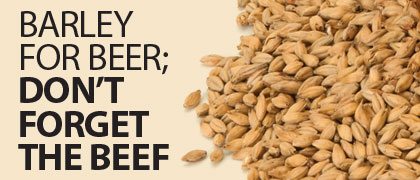
While barley research sees increased funding for malting and ingredient development, investment for feed barley falls flat.
In early 2014, barley science in Canada received a major boost with the signing of agreements for the Adding Value to Barley National Research Cluster project, which will infuse millions of dollars into improving the crop.
Canada’s barley acreage has dropped by around 116,000 acres per year since 1980, according to Statistics Canada. In 2014, roughly six million acres of barley were seeded in Canada.
Project supporters include Agriculture and Agri-Food Canada, Western Grains Research Foundation, the Brewing and Malting Barley Research Institute, the Rahr Corporation, the Atlantic Grains Council, the Barley Council of Canada and Alberta Barley.
“By collaborating on research at a nation level, barley is poised to recapture a significant portion of seeded acreage,” says Brian Otto, chair of the Barley Council of Canada. “We are pleased that these projects focus on market pull for high quality Canadian feed, malt, malt products and healthy food, which will provide the incentive for producers to seed more acres to barley.”
The cluster will focus on barley ingredient development for food manufacturers and creating new barley varieties that contain more health components.
But Reynold Bergen, science director for the Beef Cattle Research Council, says support for Canada’s barley breeding programs needs to come from livestock producers who need it for swath grazing, silage or feed grain.
“Barley breeding can’t even be taken for granted in Alberta, where more than half of Canada’s barley is grown and two-thirds of Canada’s cattle are fed,” Bergen says. “In 2007, Alberta Beef Producers became deeply concerned that Alberta’s provincial government intended to shift its breeding programs and resources from feed to biofuel crops. Alberta Beef Producers invested $1.5 million in provincial check-off funds in the feed breeding program at Alberta Agriculture’s Field Crop Development Center in Lacombe.”
Bergen says this soon led to greatly increased interest and support from provincial government funders. In addition to ensuring that Alberta Agriculture maintained their feed grain breeding program, Bergen explains that these investments also ensured that they recruited a new scientist to lead the program after the retirement of Jim Helm.
Additional industry support from Alberta Beef Producers, National Check-off funds from the Beef Cattle Research Council and the Alberta Cattle Feeders Association has helped to continue the momentum in this key feed grain and annual forage breeding program, Bergen reports.
“These researchers work with other breeders at AAFC Brandon and the University of Saskatchewan to screen new lines for disease resistance, agronomic performance and forage and feed grain yield and quality in different climates and growing conditions,” Bergen says. “They collaborate with grain breeders around the world so that Canada can benefit from new genetic material in other barley-growing parts of the world.”
Julie Deering














